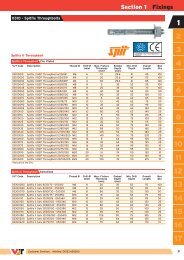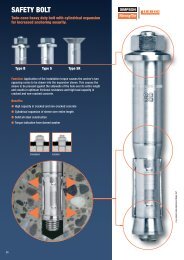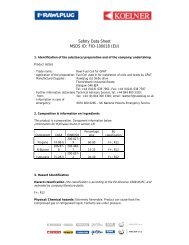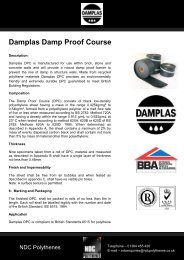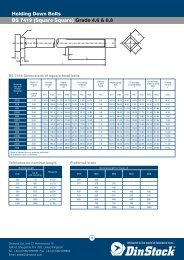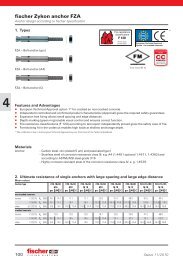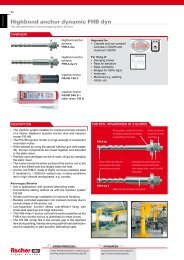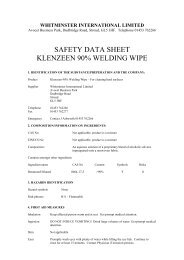Damplas Damp Proof Membrane
Damplas Damp Proof Membrane - NDC Polythenes
Damplas Damp Proof Membrane - NDC Polythenes
- No tags were found...
You also want an ePaper? Increase the reach of your titles
YUMPU automatically turns print PDFs into web optimized ePapers that Google loves.
<strong><strong>Damp</strong>las</strong> <strong>Damp</strong> <strong>Proof</strong> <strong>Membrane</strong><br />
Description<br />
<strong><strong>Damp</strong>las</strong> <strong>Damp</strong> <strong>Proof</strong> <strong>Membrane</strong> is intended for use within solid concrete<br />
floors to prevent the rise of moisture or damp through structure flooring.<br />
Manufactured from recycled polythene to meet PIFA and BBA standards,<br />
<strong><strong>Damp</strong>las</strong> DPM provides a durable and versatile DPM suitable for most<br />
construction damp proofing requirements.<br />
Composition<br />
<strong><strong>Damp</strong>las</strong> <strong>Damp</strong> <strong>Proof</strong> <strong>Membrane</strong> is manufactured from blown extruded<br />
polythene film. Produced to PIFA requirements they are available in either<br />
blue or black and a choice of either 250 Micron or 300 Micron thicknesses.<br />
Each sheet has a high puncture resistance and if applied to a smooth surface<br />
should be able to withstand normal construction site traffic conditions.<br />
Application<br />
<strong><strong>Damp</strong>las</strong> DPM is suitable for use in most floor and site conditions not subject<br />
to hydrostatic pressure.<br />
The DPM can be used as either below the slab application, directly below the<br />
flooring surface or in a sandwich construction, between base concrete and the<br />
screed.<br />
<strong><strong>Damp</strong>las</strong> DPM is not recommended for use as a general gas proof barrier<br />
system on Brownfield sites or in applications where gases such as radon are<br />
present. Instead it is recommended that <strong><strong>Damp</strong>las</strong> Gas <strong>Proof</strong> <strong>Membrane</strong> should<br />
be used within these circumstances.<br />
Instillation.<br />
Unless the application surface is smooth it should be blinded with compacted<br />
soft sand to guarantee a soft bed, free from any objects that may puncture the<br />
membrane during installation or when concrete is applied.<br />
It is recommended that the DPM should be covered with a protective layer or<br />
screed as soon as possible after the membrane has been installed. Care<br />
should be taken when applying concrete or screed on top of the DPM to avoid<br />
stretching or the DPM being displaced.<br />
NDC Polythenes<br />
Telephone – 01384 455 426<br />
E-mail – ndcenquiries@ndcpolythenes.co.uk
When joining two sheets of DPM a minimum overlap of 150mm should be<br />
provided between each of the sheets. For the best waterproof protection when<br />
making a join a double welted fold should be formed between the joining<br />
sheets. This should be formed by an overlap of 300mm from both sheets.<br />
Alternatively the 150mm overlap can be sealed with 100mm wide jointing tape.<br />
Any Punctures in the membrane should be patched with sheets of identical<br />
thickness lapped at least 150mm away from the perforation edge and sealed<br />
with double sided pressure sensitive tape.<br />
When installed within structures <strong>Damp</strong> <strong>Proof</strong> <strong>Membrane</strong> should be linked to<br />
the <strong>Damp</strong> <strong>Proof</strong> Course within the structure walls to from a continuous damp<br />
proof barrier throughout the structure.<br />
Storage and Handling<br />
This product is chemically inert and is not affected by acids or alkalines that<br />
may be present in soils.<br />
The product should not be used in applications where it is exposed to outdoor<br />
weathering for long periods as extended exposure to ultraviolet light damages<br />
the product.<br />
NDC Polythenes<br />
Telephone – 01384 455 426<br />
E-mail – ndcenquiries@ndcpolythenes.co.uk



